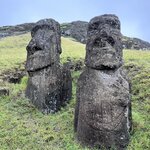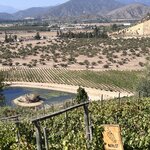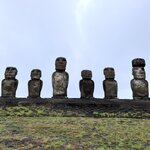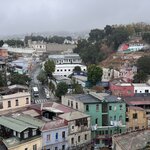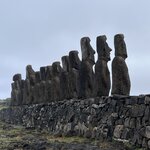
Easter Island & Santiago - 6 Days

Highlights
- Discover Santiago de Chile on a city tour
- Stroll the hillside streets of Colorful Valparaíso
- Visit Easter Island and learn the secrets of the moai, the great stone idols found nowhere else on earth
Brief Itinerary
| Day | Highlights | Overnight |
|---|---|---|
| Day 1 | Arrive in Santiago, City Tour | Santiago |
| Day 2 | Day Trip to Valparaíso & Wine Tour | Santiago |
| Day 3 | Fly to Easter Island, Optional Activities | Easter Island |
| Day 4 | Rapa Nui Full-Day Tour | Easter Island |
| Day 5 | Orongo & Ahu Akivi | Easter Island |
| Day 6 | Return to Santiago, Depart |
Detailed Itinerary
Day 1: Arrive in Santiago, City Tour

Welcome to Chile! Upon arrival at Santiago International Airport, a driver will meet you and transfer you to your hotel. But rather than idle indoors, we want you to get out and experience the pulse of this Latin American metropolis. And like any great city, that pulse is found in its people, marketplaces, and cuisine. To that end, you'll immediately head back out on an easy and delicious half-day tour of the city. By the end of it, you'll be an honorary Santiaguino.
Highlights of the tour include:
- Wandering the aisles of Santiago's labyrinthine Mercado Central and Mercado La Vega. These markets are the beating heart of the city, overflowing with vendors and local residents eager to get their hands on the day's fresh produce. With the assistance of an English-speaking guide, you'll engage with these vendors and shoppers, learning about their daily routine while getting the inside track on the most delicious tidbits to try.
- A visit to the Plaza de Armas, located in Santiago's historic center. There's a lot of history within the four corners of this expansive stone plaza, as it was founded back in 1541. Also here is the impressive Catedral Metropolitana, a neoclassical church dating to 1748 and whose towering twin bell towers dominate the north side of the plaza.
- Ascend to the top of Cerro San Cristóbal. You'll hop on a cable car to the top of this hill that sits 984 feet (300 m) above the city. Enjoy the 360 degrees panoramas and take plenty of photos, as these are the most incredible views in Santiago.
- Enjoy dinner in the fashionably bohemian enclave of Barrio Bellavista. This is the trendiest neighborhood in the city, and here you'll find a diverse array of funky cafés, international eateries, and high-end restaurants.
Day 2: Day Trip to Valparaíso & Wine Tour

After breakfast, you'll depart from your hotel bound for the historic Chilean coastal city of Valparaíso. This is a special treat because Valparaíso isn't only a UNESCO World Heritage Site but also the most romantic and artistic city in the country.
But that's not all. En route, you'll stop at an organic winery in the Casablanca Valley for a guided tour and tasting. The owners of the Emiliana Winery pride themselves on their all-natural approach to growing grapes, which utilizes the combined efforts of plants and livestock to help fertilize the crops. You'll tour the vineyard and the production facilities and then taste four different wines paired with local cheeses and chocolates.
Shortly after the tour, you'll arrive in Valparaíso. This colorful, well-preserved seaport is a throwback to the turn of the 20th century when electric trolleys coasted along the waterfront, and lurching funicular elevators carried passengers to the highest points in the city. The tour of Valparaíso begins at the port, where you'll travel by trolley between Plaza Sotomayor and Plaza Aníbal Pinto. Then, it's time to hop in the Reina Victoria funicular and ascend to the top, where you'll be greeted with panoramic views of the city.
You'll then wander the high streets through hilly neighborhoods like Cerro Alegre, Cerro Concepción, and Cerro Florida. This is the best way to get to know Valparaíso, as there's nothing quite like strolling among the brightly painted houses, old churches, and cobbled squares that comprise this city. And no matter where you happen to be, you can always find sweeping views of the Pacific coast and the blanket of blue water running out to the horizon. After the tour, you can enjoy an optional lunch in a local restaurant (try the seafood; it's some of the best in South America). Then, it's time to hop back in the minivan, transfer back to Santiago, and return to your hotel.
Chat with a local specialist who can help organize your trip.
Day 3: Fly to Easter Island, Optional Activities

Today, you'll arrive at the most remote inhabited land in the world: Rapa Nui, or Easter Island as it's commonly known. After breakfast, you'll transfer from your hotel to the airport, where you'll catch a flight to the island. The flight is three hours, so you'll arrive on Rapa Nui with most of the afternoon to spare. After transferring to your hotel and checking in, you can spend the remainder of the day exploring.
There are around 600 stone figures, or moai, on this island, some of which reach 32 feet (10 m) in height. You'll find many of them standing on the stone ahu (ceremonial pillars) that dot the island's green hillsides. They were fashioned out of volcanic rock by obsidian tools by the first settlers from Polynesia sometime after they arrived in 800 CE. The figures represented deceased leaders of the five tribes that once inhabited the island and supposedly offered spiritual protection. Around the 16th century, the islanders exceeded their natural resources, and as a result of famine and war, they tore down many of the idols, believing them to have outlasted their usefulness.
By the 19th century, Europeans, smallpox, and slavery arrived, wiping out some of the population while more emigrated to Tahiti to work on the plantations. Eventually, the population rebounded, and Rapa Nui was annexed to Chile in 1888. Today, locals are governed ostensibly under the oversight of a council of Indigenous chiefs.
Some recommended activities on the island include:
- Explore Hanga Roa. This is the main town on Easter Island. There are just over 3,000 residents here, which comprise 87% of the island's inhabitants. Hanga Roa has a small-town coastal vibe, and you can find restaurants serving unique food like ceviche, empanadas stuffed with fresh tuna, po'e (a pumpkin and plantain cake), and taro ice cream.
- Visit the Museo Antropológico Sebastián Englert. For an intro to island life, visit the anthropological museum and view exhibits celebrating the Indigenous patrimony, such as ancient tools, totems, sculptures, and more.
- Take a hike outside of town to Ahu Tahai, one of the aforementioned ceremonial altars; this one fronts the ocean. Here, there are some moai as well as caves nearby. It also makes a great sunset viewing spot.
Day 4: Rapa Nui Full-Day Tour

After breakfast, you'll embark on a full-day tour of the island. It's an informative journey that will shed light on Rapa Nui's famous archaeological sites. You'll start at Ahu Te Pito Kura, a unique rock structure featuring a central stone that, legend has it, was brought over by a king of the first tribes and supposedly still emits spiritual power.
Then, it's off to Rano Raraku, an impressive volcanic crater, at the base of which you'll find many moai. After that, you'll enjoy a delicious snack at Ahu Tongariki, considered the biggest ceremonial platform on the island. Here, there are fifteen moai displayed in a row. After touring the site, you'll visit another ceremonial platform called Ahu Akahang and finish the day at the beautiful white-sand beach of Anakena.
Day 5: Orongo & Ahu Akivi

In the morning, you'll travel a few minutes to the southwest corner of Rapa Nui and the remains of the village of Orongo. Located on the rim of an inactive volcano called Rano Kau, this area enjoys a special place in the island's history as it was the principal site of what's known as the "Birdman" era. The cult of the Birdman was the belief system that took root in Rapa Nui in the 1500s after locals mostly gave up on the moai due to war and famine.
The cult of the Birdman was also a contest. To appease their deity, called Meke-Meke, islanders would hold an annual competition to see who be crowned the next chief. The contest involved a group of men swimming to two nearby islands and waiting until terns laid their first eggs of the season. Whoever returned with the first egg became chief for a year (the "Birdman"), and Orango was the ceremonial village in which he was crowned.
You'll not only visit the village and the volcano but also a cave by the sea known as Ana Kai Tangata. Inside this cave, you'll see petroglyphs done by the ancient inhabitants of the island. This excursion ends in the early afternoon and concludes the first tour of the day.
The second tour involves a trip about a mile inland to visit Ahu Akivi. This ahu is unique in that not only is it home to seven moai, but in ancient times, it also doubled as a celestial observatory. That's right, this is where islanders came to stargaze. An interesting feature is that the seven moai face sunset during the spring equinox, and their backs are to the sunrise during autumn. While here, you'll take a short hike to two other archaeological sites: the cave of Ana Te Pahu, the largest cavern on Rapa Nui, and the Puna Pau volcano, which, for ancient islanders, doubled as a quarry in which they extracted the rocks necessary to carve the moai.
Day 6: Return to Santiago, Depart

This marks your last day on the island. Depending on your flight schedule, you should have some time to explore Rapa Nui a bit more before transferring to the airport. Once you do, you'll hop on a flight back to Santiago and catch your connecting flight home.
More Great Chile Itineraries
Looking for more inspiration for your trip to Chile? Check out these other Chile itineraries, explore different ways to spend six days in Chile, or discover the best time to visit Chile.

